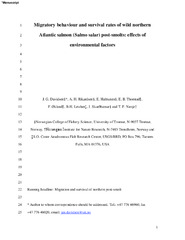Migratory behaviour and survival rates of wild northern Atlantic salmon (Salmo salar) post-smolts: effects of environmental factors
Permanent link
https://hdl.handle.net/10037/2431DOI
DOI: 10.1111/j.1095-8649.2009.02423.xDate
2009-12-03Type
Journal articleTidsskriftartikkel
Peer reviewed
Author
Thorstad, EB; Davidsen, Jan Grimsrud; Økland, F.; Rikardsen, Audun H.; Halttunen, Elina; Letcher, B.H,; Skardhamar, Jofrid; Næsje, TorAbstract
To study smolt behaviour and survival of a northern Atlantic salmon (Salmo salar) population during river descent, sea entry and fjord migration, 120 wild S. salar were
tagged with acoustic tags and registered at four automatic listening station arrays in the mouth of the North Norwegian River Alta and throughout the Alta Fjord. An estimated 75% of the post-smolts survived from the river mouth, through the estuary and the first 17 km of the fjord. Survival rates in the fjord varied with body length, and ranged from 97.0–99.5% per km. On average, the post-smolts spent 1.5 days (36 h, range 11–365 h) travelling from the river mouth to the last fjord array, 31 km from the river mouth. The migratory speed was slower (1.8 bl sec-135 ) in the first 4 km after sea entry compared to the next 27 km (3.0 bl sec-136 ). Post-smolts entered the fjord more often during the high or ebbing tide (70%). There was no clear diurnal migration pattern within the river and fjord, but most of the post-smolts entered the fjord at night (66%, 2000–0800 hours), despite the 24 h daylight at this latitude. The tidal cycle, wind-induced currents and the smolts‟ own movements seemed to influence migratory speeds and routes in different parts of the fjord. A large variation in migration patterns, both in river and fjord, might indicate that individuals in stochastic estuarine and marine environments are exposed to highly variable selection regimes resulting in different responses to environmental factors on both temporal and spatial scales. Post-smolts in northern Alta Fjord had similar early marine survival rates to those observed previously in southern fjords; however fjord residency in the north was shorter.
Description
This is the accepted version (authors' final draft post review) of the paper, reprinted with permission. Published version available at http://dx.doi.org/10.1111/j.1095-8649.2009.02423.x


 English
English norsk
norsk